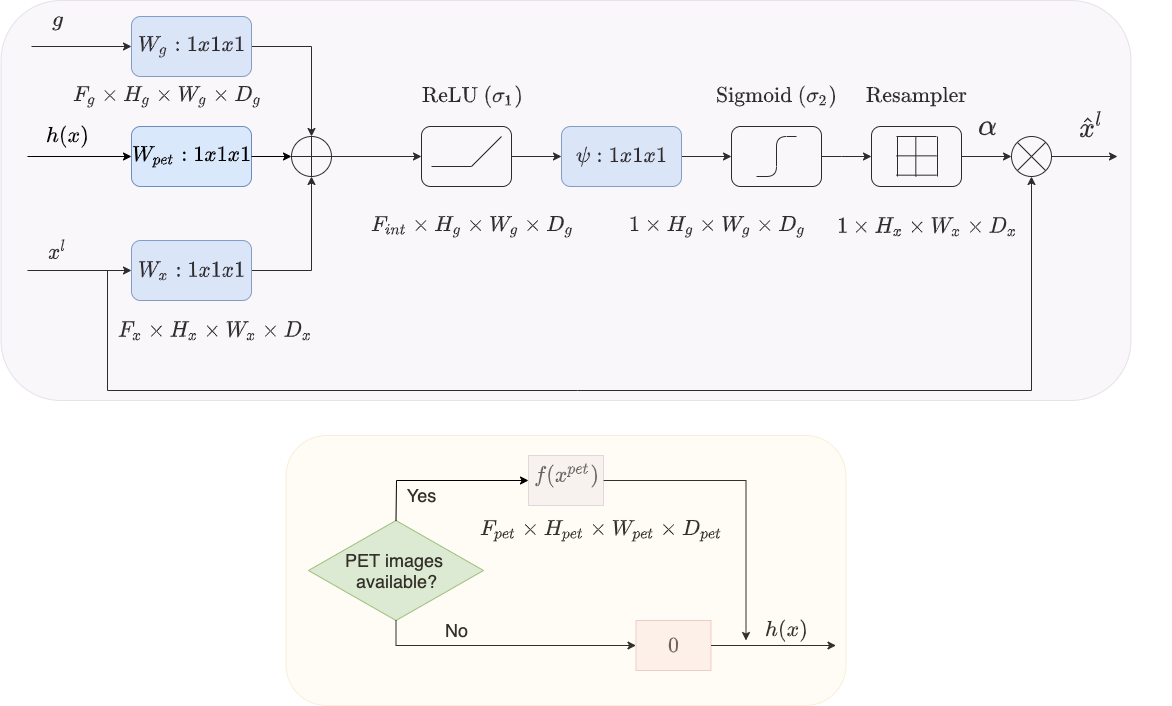PET Guided Attention Network for segmentation of lung tumors from PET/CT images that accounts for missing PET images
This project is my part of my Master Thesis at ETH Zurich, Switzerland.
Please find the complete report here
Master Thesis report
The work was accepted in “ICML 2020 Global Health workshop” for a poster presentation.
Extended abstract
Poster
The work was also accepted at DAGM-GCPR conference
PET/CT imaging is the gold standard for the diagnosis and staging of lung cancer. However, especially in healthcare systems with limited resources, costly PET/CT images are often not readily available. Conventional machine learning models either process CT or PET/CT images but not both. Models designed for PET/CT images are hence restricted by the number of PET images, such that they are unable to additionally leverage CT-only data. In this work, we apply the concept of visual soft attention to efficiently learn a model for lung cancer segmentation from only a small fraction of PET/CT scans and a larger pool of CT-only scans. We show that our model is capable of jointly processing PET/CT as well as CT-only images, which performs on par with the respective baselines whether or not PET images are available at test time. We then demonstrate that the model learns efficiently from only a few PET/CT scans in a setting where mostly CT-only data is available, unlike conventional models.
We achieve this robustness of the model by allowing PET images to act as an optional guide in addition to the gating/query signal (which is usually the encoded feature representation) of a simple attention gate.
The following Figures show the architecture of the network and the attention gate respectively.
The Baseline models require conda environment. Main dependencies are:
- PyTorch (GPU)
- cv2 (OpenCV)
- cc3d (See [https://github.com/seung-lab/connected-components-3d])
Further, dependencies can be found in the environemnt.yml
Create the conda environment
conda env create -f environment.ymlTo pre-process the data and generate data augmentations run
> python data/data_preprocessing.py --save_dir tumor_data/ --data_augusage: Data pre-processing for PAG model [-h] [--anim] [--save_dir SAVE_DIR]
[--data_aug]
optional arguments:
-h, --help show this help message and exit
--anim Generate animations of pre-processed images?
--save_dir SAVE_DIR Where to save data?
--data_aug Should perform data augmentation?
The configurations are set according to defined in config.json file
> python -u loader.py --config config.json --train # To train the model
> python -u loader.py --config config.json --valid # To generate predictions on validation data
> python -u loader.py --config config.json --test # To generate predictions on test data
To submit the job on LSF batching system. The model reuqires GPU for training, validation and testing
> bsub -o output.txt -W 48:00 -R "rusage[mem=15000,ngpus_excl_p=1]" -R "select[gpu_mtotal0>=14000]" python -u loader.py --train
usage: Segmentation of lung tumors PAG model and baselines [-h]
[--config CONFIG]
[--method METHOD]
[--train] [--valid]
[--test]
[--exp_name EXP_NAME]
[--save_dir SAVE_DIR]
[--ckpt_file CKPT_FILE]
[--fold FOLD]
[--n_folds N_FOLDS]
[--n_epochs N_EPOCHS]
[--lr LR]
optional arguments:
-h, --help show this help message and exit
--config CONFIG Configuration file
--method METHOD Which model?
--train Train the model?
--valid Train the model?
--test Train the model?
--exp_name EXP_NAME Name of the experiment
--save_dir SAVE_DIR Where do you want to save ?
--ckpt_file CKPT_FILE
Optional path for checkpoint
--fold FOLD Fold no. in CV experiments
--n_folds N_FOLDS No. of folds
--n_epochs N_EPOCHS Number of epochs
--lr LR learning rate
To calculate metrics on validation dataset.
python validate/validate.py --dirs multi-baselines/ct/cv0/ --detect --analyze --valid ;
usage: Data analysis [-h] --dirs DIRS [DIRS ...] [--anim] [--analyze]
[--detect] [--train] [--valid] [--test] [--config CONFIG]
[--clusters CLUSTERS]
optional arguments:
-h, --help show this help message and exit
--dirs DIRS [DIRS ...]
All the directories you want
--anim Do you want animations?
--analyze Calculate metrics?
--detect Generate metrics?
--train Analyze for training data?
--valid Analyze for validation data?
--test Analyze for test data?
--config CONFIG json file
--clusters CLUSTERS Name of the file to store summary statistics
To generate the CV metrics for a directory
python validate/cv_analyze.py --dir multi-baselines/ct/;
python validate/dir_analyze.py --dirs \
multi-baselines/ct/ \
multi-baselines/ct_attn/ \
pag/less/complete/PAG-ct/ \
pag/less/complete/PAG-ct-pet/ \
pag/fractions/complete/ \
multi-baselines/bimodal_attn/ --save_dir metrics_plots_v1/
python validate/rstr_analyze.py --save_dir metrics_plots_v1/

